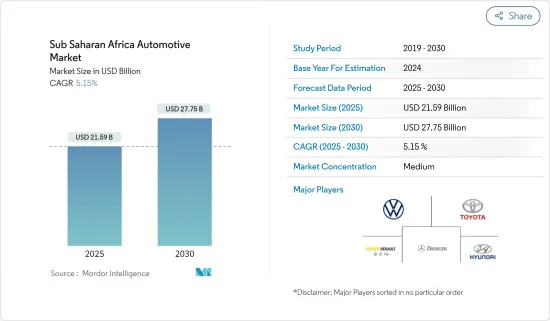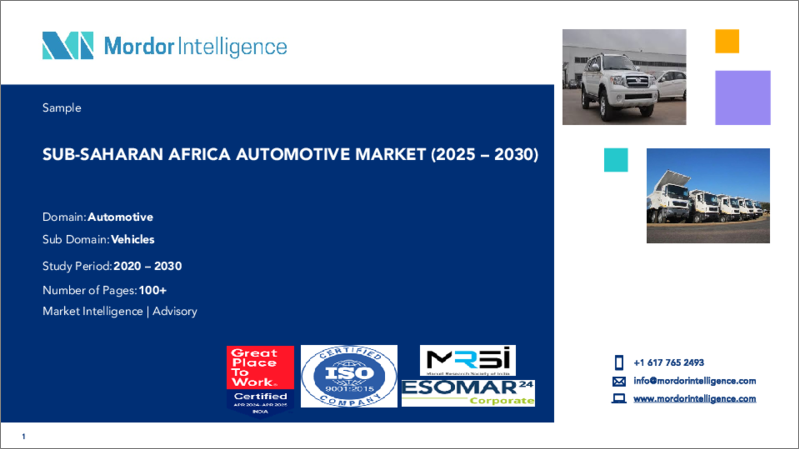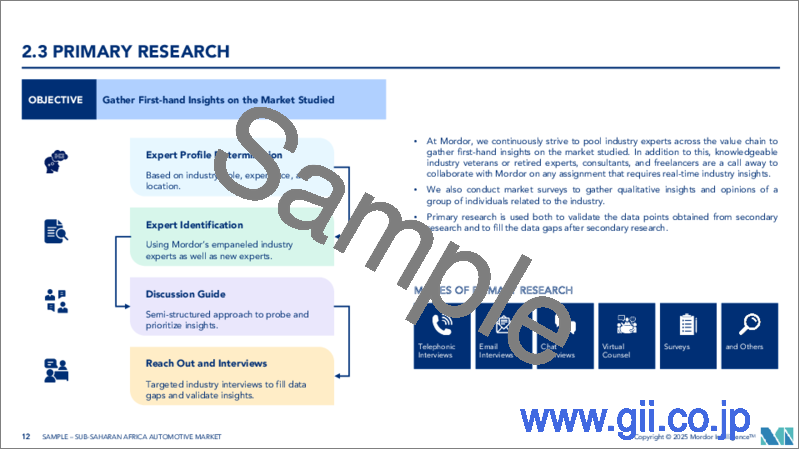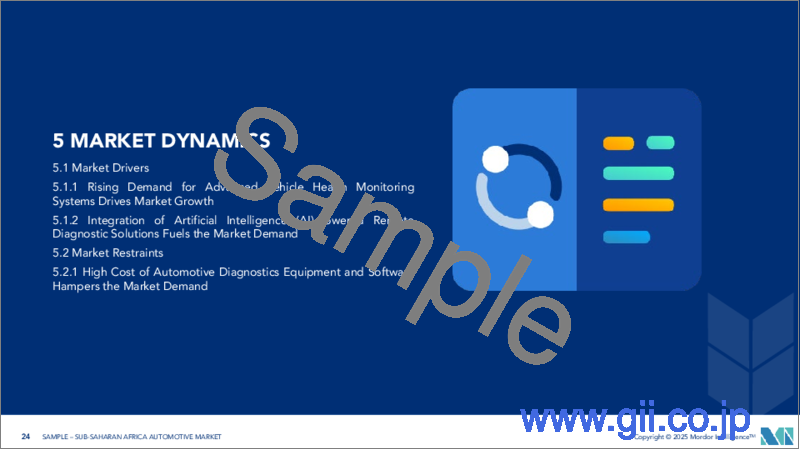|
|
市場調査レポート
商品コード
1689725
サハラ以南のアフリカの自動車:市場シェア分析、産業動向、成長予測(2025年~2030年)Sub Saharan Africa Automotive - Market Share Analysis, Industry Trends & Statistics, Growth Forecasts (2025 - 2030) |
||||||
カスタマイズ可能
適宜更新あり
|
|||||||
| サハラ以南のアフリカの自動車:市場シェア分析、産業動向、成長予測(2025年~2030年) |
|
出版日: 2025年03月18日
発行: Mordor Intelligence
ページ情報: 英文 90 Pages
納期: 2~3営業日
|
全表示
- 概要
- 目次
サハラ以南のアフリカの自動車市場規模は、2025年に215億9,000万米ドルと推定され、予測期間(2025~2030年)のCAGRは5.15%で、2030年には277億5,000万米ドルに達すると予測されます。

COVID-19の大流行は市場に大きな影響を及ぼし、需要はCOVID以前の水準に依然として遅れをとっています。2018年、アフリカ地域の新車需要は増加していました。しかし、地域全体の政府は、輸入中古車の禁止を実施することで、自動車産業を活性化させる取り組みを行っています。国家自動車設計開発評議会(NADDC)のデータによると、ナイジェリアは年間約30万台から40万台の自動車の輸入に約2兆8,800億NGN(80億米ドル)を費やしています。
中期的には、サハラ以南のアフリカでは、ルワンダのEV販売に対する免税措置のように、自動車の電動化目標やEV導入のインセンティブを発表し始めた政府もあります。さらに、この地域では、電動二輪車に焦点を当てたEVの新興企業エコシステムが急成長しています。自動車の専門家によると、2021年末時点で、このエコシステムには20社以上の新興企業があり、その年の資金調達総額は2,500万米ドルを超えています。
さらに、ナイジェリアは自動車の輸入を抑制し、現地での自動車生産を奨励するため、70%の輸入関税と輸入車への課税を打ち出しました。その結果、ナイジェリア国内での現地組立・製造車両の台数が増加し、ほとんどの現地企業は製造プロセスと製造能力の開発に成功しました。例えば
主要ハイライト
- Innoson Vehicles Manufacturing Limited(IVM)は2019年、アナンブラ州Nnewiにバス製造用の自動化工場を新設しました。この自動化工場により、15~17人乗りの新型ハマー・バスのコストが1,600万NGNから900万NGNに削減されました。
しかし、可処分所得が低く、新車にかかるコストが非常に高いため、中古車がサハラ以南の国々の自動車小売セクタの大半を占めています。これらの自動車は主に、欧州、日本、米国など、中古車の再販価格や残存価値が低い地域から輸入されています。これは予測期間中、対象市場の妨げになる可能性があります。
アフリカ自動車市場の動向
他の代替燃料の増加が市場の需要を牽引
現在、輸送はアフリカの温室効果ガス(GHG)排出総量の10%を占めており、サハラ以南のアフリカの自動車市場が拡大するにつれて、この数字は上昇すると予想されます。サブサハラ・アフリカの年間自動車販売台数の約70%、同地域の人口の約45%を占める6カ国(南アフリカ、エチオピア、ルワンダ、ウガンダ、ケニア、ナイジェリア)では、都市化と所得の増加に伴い、自動車保有台数が現在の2,500万台から2040年までに推定5,800万台に増加すると予想されています。自動車パークが拡大する中、サハラ以南のアフリカの課題は、よりサステイナブルモビリティを推進すると同時に、世界で不要になった中古内燃機関車のゴミ捨て場になることを避けることです。
機運が高まる一方で、サハラ以南のアフリカは、電気モビリティへの移行において、場合によっては不安定な電力供給、低い車両価格、中古車への依存など、いくつかの独特な課題に直面しています。多くの国々が電力アクセスの改善に向けて大きく前進している(言及した6カ国すべての都市部の電力アクセス率が70%を超え、中には90%を超える国もある)が、電力の信頼性には依然として懸念が残る。さらに、サハラ以南のアフリカの2020年システム平均中断指数(SAIDI)は39.30と報告されており、OECD高所得国の0.87と比較しています。
アフリカのインフラも改善しつつあり、これは同地域の自動車市場を後押しします。2023年まで成長を牽引すると予想される国もあり、ガーナなどは重要な役割を果たしています。
- ガーナは2030年までに先進国になることを目指しています。同国が目標の半分でも達成すれば、経済成長と自動車市場の成長は正比例するため、ガーナの自動車市場は急ピッチで拡大すると予想されます。
また、さまざまな企業がこの地域で電気自動車を発売、または発売を計画しており、今後数年間でかなりの市場シェアを占めることが予想されます。例えば
- 最近発売されたEleksa CityBugは、南アフリカの道路を走る最も手頃な価格のEVです。新型Eleksaの販売価格はR23万です。南アフリカでは、CityBugの走行性能はまだ証明されていないです。
南アフリカは大陸最大の自動車産業になる見込み
自動車金利はサハラ以南のアフリカ諸国では毎年変動しており、各国の経済成長に大きく左右されます。南アフリカの自動車産業は、まだ市場原理に適応している段階です。輸入車の増加と世界経済危機の後遺症、特に欧州市場に関する不確実性と国内輸出への影響は、製造業に影響を及ぼしています。
こうした力は、自動車アフターマーケットにも対応を求めています。両セグメントとも、電気料金や原料価格の高騰、人件費の上昇、生産性の低さ、柔軟性の欠如などの影響を受けています。自動車会社は、生き残り、成長するために、顧客との関係を継続的に開発・維持し、卓越した技術を達成し、熟練した労働力を確保し、重大なリスクを管理しなければならないです。
2022年の南アフリカの自動車販売台数。6月の乗用車販売台数は、トヨタが7,086台(シェア18.4%)、VWが5,652台(シェア14.7%)、Suzukiが4,622台(シェア12.0%)でした。商用車では、Daimler Trucks and Busesが387台(シェア14.9%)、Toyotaが353台(同13.6%)、Isuzuが322台(同12.4%)を販売しました。
アフリカ自動車産業概要
この地域の自動車産業は、Volkswagen、Toyota、Nissan、Hyundai、Suzukiといった大手メーカーが独占しています。最近の動向をいくつか発表します。
- 2022年7月、南アフリカ仕様のCretaの外観アップグレードは、インドネシアで販売されている新型と共通です。これには、新世代ツーソンの「Parametric Jewel」デザインのグリルとスプリットLEDヘッドライトが含まれます。インテリアは、8インチのタッチスクリーンが追加されただけで、ほとんど変わっていないです。最大6つのエアバッグ、エレクトロニック・スタビリティコントロール(ESC)、EBD付きABSを装備。
- 2022年8月、Maruti Suzukiは新型コンパクトSUVグランド・ビターラも海外市場で発売しました。グランド・ビターラSUVは最近、正式発売に先立ち、インド最大の自動車メーカーが南アフリカで披露しました。S字型クロスの代わりとなるグランド・ビターラ
- ナイジェリアで締結されたMoUにおいて、Volkswagenは、製造/生産事業を段階的に拡大し、ナイジェリアを長期的にアフリカ西海岸の自動車ハブにすることを約束しました。
その他の特典
- エクセル形式の市場予測(ME)シート
- 3ヶ月間のアナリストサポート
目次
第1章 イントロダクション
- 調査の前提条件
- 調査範囲
第2章 調査手法
第3章 エグゼクティブサマリー
第4章 市場力学
- 市場の促進要因
- 市場抑制要因
- 産業の魅力-ポーターのファイブフォース分析
- 新規参入業者の脅威
- 買い手/消費者の交渉力
- 供給企業の交渉力
- 代替品の脅威
- 競争企業間の敵対関係の強さ
第5章 市場セグメンテーション
- ボディスタイルタイプ
- ハッチバック
- セダン
- スポーツユーティリティビークル
- その他(ミニバン、MPVなど)
- 車種別
- 乗用車
- 商用車
- 燃料タイプ別
- ガソリン
- ディーゼル
- その他の代替燃料
- 国名
- 南アフリカ
- ナイジェリア
- ケニア
- エチオピア
- ガーナ
- その他の国(タンザニア、アンゴラ、ザンビアなど)
第6章 競合情勢
- ベンダー市場シェア
- 企業プロファイル
- Toyota Motor Corporation
- Volkswagen AG
- Hyundai Motor Company
- Groupe Renault
- Nissan Motor Co., Ltd.
- Isuzu Motors Ltd
- Ford Motor Company
- Honda Motor Company, Ltd.
- Subaru Corporation
- Suzuki Motor Corporation
第7章 市場機会と今後の動向
The Sub Saharan Africa Automotive Market size is estimated at USD 21.59 billion in 2025, and is expected to reach USD 27.75 billion by 2030, at a CAGR of 5.15% during the forecast period (2025-2030).

The COVID-19 pandemic had a significant impact on the market, and demand is still lagging behind pre-COVID levels. Until 2018, the demand for new vehicles in the African region increased. However, governments across the region are taking initiatives to boost the automotive industry by implementing a ban on imported used vehicles. According to the data from the National Automotive Design and Development Council (NADDC), Nigeria spends about NGN 2.88 trillion (USD 8 billion) on the importation of about 300,000 to 400,000 cars, yearly.
Over the medium term, some governments in Sub-Saharan Africa have begun to announce vehicle electrification targets and incentives for EV adoption, such as Rwanda's tax exemptions for EV sales. Furthermore, a burgeoning start-up ecosystem for EVs, with a focus on electric two-wheelers, is emerging in the region. According to automotive experts, there were more than 20 start-ups in the ecosystem at the end of 2021, with total funding of more than $25 million that year.
Additionally, to discourage the importation of vehicles and encourage local vehicle production, Nigeria slammed 70% import duty and levied on imported vehicles. This resulted in increased volume of locally assembled and manufactured vehicles in the country and most of the local companies have seen developments in their manufacturing process and capacity. For instance,
Key Highlights
- Innoson Vehicles Manufacturing Limited (IVM) opened a new automated plant for manufacturing bus at Nnewi, Anambra State, in 2019. The automated plant reduced the cost of new 15-17-seater Hummer bus from NGN 16 million to NGN 9 million.
However, Due to low disposable income and very high cost associated with new vehicles, used vehicles dominate some of sub-saharan countries automotive retail sector. These vehicles are mainly imported from regions with low resale or residual values of used vehicles like Europe, Japan, and the United States. This might hamper the target market during the forecasted timeperiod.
Africa Automotive Market Trends
Rising Other Alternative Fuel to Drive Demand in the Market
Transport currently accounts for 10% of Africa's total greenhouse gas (GHG) emissions, and this figure is expected to rise as Sub-Saharan Africa's vehicle park expands. The vehicle parc is expected to grow from 25 million vehicles today to an estimated 58 million by 2040 in the six countries that account for roughly 70% of Sub-Saharan Africa's annual vehicle sales and 45 percent of the region's population (South Africa, Ethiopia, Rwanda, Uganda, Kenya, and Nigeria), driven by urbanization and rising incomes. As its vehicle park expands, Sub-Saharan Africa's challenge will be to push for more sustainable mobility while avoiding becoming a dumping ground for the world's unwanted used ICE vehicles.
While momentum is building, Sub-Saharan Africa faces some unique challenges in its electric mobility transition, including unreliable electricity supply in some cases, low vehicle affordability, and reliance on used vehicles. Many countries have made significant progress toward improving electricity access (all six countries mentioned have urban electricity access rates above 70%, with some exceeding 90%); however, electricity reliability remains a concern. Furthermore, the 2020 System Average Interruption Disruption Index (SAIDI) for Sub-Saharan Africa was reported to be 39.30, compared to 0.87 for OECD high-income countries.
Africa's infrastructure is also improving, which will help the region's automotive market. Some countries are expected to drive growth until 2023, with countries such as Ghana playing key roles.
- Ghana aspires to be a developed nation by 2030. If the country meets even half of its target, the Ghanaian automotive market is expected to expand at a rapid pace, as economic growth is directly proportional to the growth of automotive markets.
Various companies are also either launching or planing to launch their electric vehicle in the region to witness a considerable market share in the upcoming years. For instance,
- The recently launched Eleksa CityBug is the most affordable EV to hit South African roads. The new Eleksa costs R230 000 at the point of sale. In the country, the CityBug is still proving its roadworthiness.
South Africa is Expected to be the Continent's Largest Automotive Industry
The vehicle interest rates have been fluctuating across the Sub-Saharan African countries annually and it is highly dependent on the economic growth of the individual country. The South African automotive industry is still adapting to market forces. The increasing number of imported vehicles and the aftereffects of the global economic crisis, particularly the uncertainty regarding European markets and the impact on local exports, are affecting manufacturing.
These forces have also required the automotive aftermarket to respond. Both areas are further impacted by rising electricity and raw material prices, as well as rising labor rates, low productivity, and a lack of flexibility. Automotive companies must continuously develop and maintain customer relationships, achieve technical excellence and retain skilled labor pools, and manage significant risks in order to survive and grow.
Auto sales in South Africa in 2022. Toyota sold 7,086 units (18.4% share) of passenger vehicle sales in June, VW sold 5,652 units (14.7% share), and Suzuki sold 4,622 units (12.0% share). Daimler Trucks and Buses sold 387 units (14.9%), Toyota 353 units (13.6%), and Isuzu 322 units (12.4%) of commercial vehicle sales in June.
Africa Automotive Industry Overview
The automotive industry in the region is dominated by leading manufacturers such as Volkswagen, Toyota, Nissan, Hyundai, and Suzuki. A few of the recent developments include:
- In July 2022, the South African variant of Creta's cosmetic upgrades is shared with the new iteration sold in Indonesia. This includes the new generation Tucson's 'Parametric Jewel' design theme for the grille and split LED headlights. The Interior remains largely unchanged, with the addition of an 8-inch touchscreen. It comes with up to six airbags, electronic stability control (ESC), and ABS with EBD.
- In August 2022, Maruti Suzuki also launched its new compact SUV Grand Vitara in foreign markets. The Grand Vitara SUV was recently showcased in South Africa by India's largest carmaker ahead of its official launch. Grand Vitara, which will take the place of the S-shaped cross.
- In the MoU signed in Nigeria, Volkswagen has committed itself to expanding manufacturing/production operations on a step-by-step basis and to turning Nigeria into an automotive hub on the western coast of Africa, over the long term.
Additional Benefits:
- The market estimate (ME) sheet in Excel format
- 3 months of analyst support
TABLE OF CONTENTS
1 INTRODUCTION
- 1.1 Study Assumptions
- 1.2 Scope of the Study
2 RESEARCH METHODOLOGY
3 EXECUTIVE SUMMARY
4 MARKET DYNAMICS
- 4.1 Market Drivers
- 4.2 Market Restraints
- 4.3 Industry Attractiveness - Porter's Five Force Analysis
- 4.3.1 Threat of New Entrants
- 4.3.2 Bargaining Power of Buyers/Consumers
- 4.3.3 Bargaining Power of Suppliers
- 4.3.4 Threat of Substitute Products
- 4.3.5 Intensity of Competitive Rivalry
5 MARKET SEGMENTATION
- 5.1 Body Style Type
- 5.1.1 Hatchback
- 5.1.2 Sedan
- 5.1.3 Sports Utility Vehicles
- 5.1.4 Others (Mini-vans, MPV, etc.)
- 5.2 By Vehicle Type
- 5.2.1 Passenger Cars
- 5.2.2 Commercial Vehicles
- 5.3 By Fuel Type
- 5.3.1 Gasoline
- 5.3.2 Diesel
- 5.3.3 Other Alternative Fuels
- 5.4 Country
- 5.4.1 South Africa
- 5.4.2 Nigeria
- 5.4.3 Kenya
- 5.4.4 Ethiopia
- 5.4.5 Ghana
- 5.4.6 Other Countries (Tanzania, Angola, Zambia, etc. )
6 COMPETITIVE LANDSCAPE
- 6.1 Vendor Market Share
- 6.2 Company Profiles
- 6.2.1 Toyota Motor Corporation
- 6.2.2 Volkswagen AG
- 6.2.3 Hyundai Motor Company
- 6.2.4 Groupe Renault
- 6.2.5 Nissan Motor Co., Ltd.
- 6.2.6 Isuzu Motors Ltd
- 6.2.7 Ford Motor Company
- 6.2.8 Honda Motor Company, Ltd.
- 6.2.9 Subaru Corporation
- 6.2.10 Suzuki Motor Corporation






